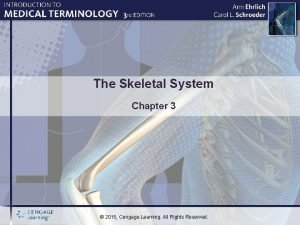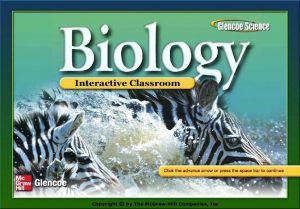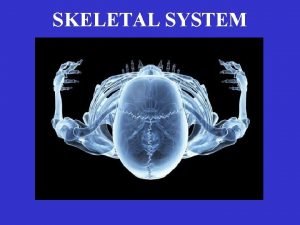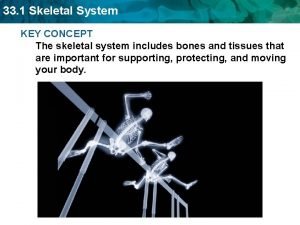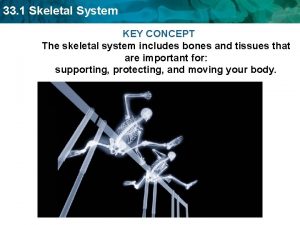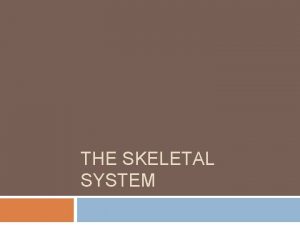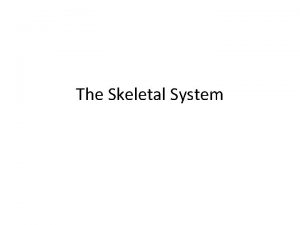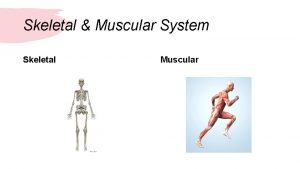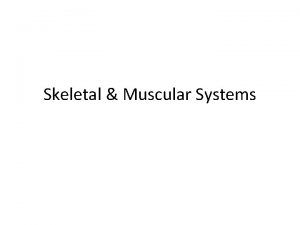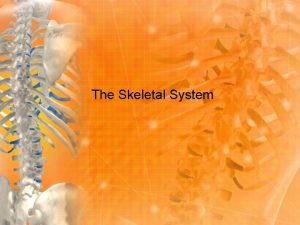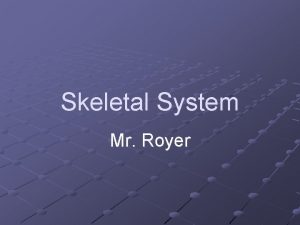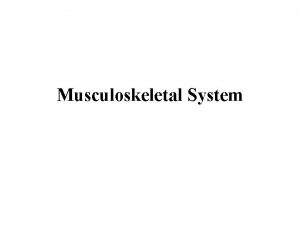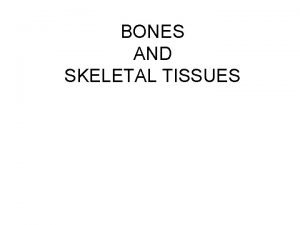33 1 Skeletal System KEY CONCEPT The skeletal



































- Slides: 35

33. 1 Skeletal System KEY CONCEPT The skeletal system includes bones and tissues that are important for supporting, protecting, and moving your body.

33. 1 Skeletal System Your skeletal system is made up of the appendicular and axial skeletons. • The skeletal system protects, supports, and moves the body.

33. 1 Skeletal System • The appendicular skeleton includes legs, arms, feet and hands. – allows for movement – includes bones called girdles that connect limbs to body

33. 1 Skeletal System • The axial skeleton includes the skull, rib cage, and spinal column. – supports body and protects skull tissues – allows for limited movement rib breastbone vertebra

33. 1 Skeletal System • Cartilage is connective tissue between bones. – cushions bones – allows for smooth movement – connect two bones cartilage

33. 1 Skeletal System Bones connect to form joints. • Joints are places were two bones meet. • There are three types of joints. – fibrous, which does not fibrous joint allow for movement

33. 1 Skeletal System Bones connect to form joints. • Joints are places were two bones meet. • There are three types of joints. – cartilaginous, which allows partial movement cartillage

33. 1 Skeletal System Bones connect to form joints. • Joints are places were two bones meet. • There are three types of joints. – synovial, which allows for greater movement

33. 1 Skeletal System • Ligaments are long bands of tissue that connect bones across a joint. ligament

33. 1 Skeletal System • There are several types of synovial joints. – gliding – pivot GLIDING JOINT – ball-and-socket PIVOT JOINT – saddle BALL-AND-SOCKET JOINT – hinge SADDLE JOINT HINGE JOINT

33. 1 Skeletal System Bones are living tissue. • Bone is made of compact bone tissue and spongy bone tissue. Compact bone Spongy bone

33. 1 Skeletal System • Compact bone is hard and dense. – Osteocytes (bone cells) maintain compact bone rings. – Haversian canals allow blood vessels in the bone. osteocytes blood vessel Haversian canals

33. 1 Skeletal System • Spongy bone protects red or yellow bone marrow. – Red bone marrow produces blood cells. – Yellow bone marrow is mostly fat. Periosteum A layer of connective tissue that covers bone Red bone marrow

33. 1 Skeletal System • Calcification is the process of building hard bone. – combines collagen and calcium phosphate – transforms cartilage into hard bone during childhood osteocyte compact bone

33. 1 Skeletal System KEY CONCEPT 33. 2 Muscles are tissues that can contract, enabling movement.

33. 1 Skeletal System Humans have three types of muscle. • The muscular system moves substances throughout the body. – bones of the skeletal system – food through digestive system – blood through circulatory system – fluids through excretory system

33. 1 Skeletal System • There are three types of muscle tissue. – skeletal muscle – smooth muscle – cardiac muscle SKELETAL MUSCLE SMOOTH MUSCLE CARDIAC MUSCLE

33. 1 Skeletal System • Skeletal muscle attaches to the skeleton by tendons. – Tendons connect muscle to bone. – Skeletal muscles are mostly voluntary. SKELETAL MUSCLE

33. 1 Skeletal System • Smooth muscle lines organs and is involuntary. – move food through digestive organs – empty liquid from the bladder – control width of blood vessels Smooth muscle around this artery allows the artery to regulate blood flow by shrinking and expanding. SMOOTH MUSCLE

33. 1 Skeletal System • Cardiac muscle is found only in the heart. – pumps blood throughout body – controlled by pacemaker – contains more mitochondria than skeletal muscle cells CARDIAC MUSCLE

33. 1 Skeletal System Muscles contract when the nervous systems causes muscle filaments to move. • Muscle fibers are cells of the muscular system. muscle fiber muscle

33. 1 Skeletal System • Myofibrils are long strands of protein in the muscle fiber. myofibril muscle fiber muscle

33. 1 Skeletal System • Each myofibril is divided into sarcomeres. • Sarcomeres contain filaments that cause contraction. muscle fiber myofibril sarcomere muscle

33. 1 Skeletal System • Each myofibril is divided into sarcomeres. • Sarcomeres contain filaments that cause contraction. – Actin filaments are pulled during contraction. – Myosin filaments pull actin during contraction. RELAXATION M line CONTRACTION myosin Z line

33. 1 Skeletal System • Neuron stimulates muscle at the neuromuscular junction neuron MUSCLE

33. 1 Skeletal System • Neuron stimulates muscle at the neuromuscular junction. – Neurotransmitters cause calcium regulatory protein channels in the sarcomere to open. – Calcium exposes binding sites. – Myosin binds to actin and pulls it. – As the sarcomere shortens, the muscle contracts. actin myosin Z line

33. 1 Skeletal System KEY CONCEPT 33. 3 The integumentary system has many tissues that protect the body.

33. 1 Skeletal System The integumentary system helps maintain homeostasis. • The integument is the body system that surrounds all your other organ systems.

33. 1 Skeletal System The integumentary system helps maintain homeostasis. • The integumentary system consists of many parts. – skin – hair – nails – oil glands – sweat glands – proteins, such as keratin

33. 1 Skeletal System • Integumentary system removes substances from the body. – water – salts – urea pore sweat glands

33. 1 Skeletal System The integumentary system consists of many different tissues. • The outermost layer of the skin is the epidermis. – dead skin cells – oils epidermis – pores pore

33. 1 Skeletal System • Cells in the epidermis produce keratin and melanin. – Keratin makes cells waterproof and tough feeling. – Melanin is a dark pigment that absorbs UV rays.

33. 1 Skeletal System • The dermis contains most of the tissues in the skin. – sweat glands – oil glands – pressure receptors – blood vessels – hair follicles hair follicle oil gland dermis pressure receptors sweat gland

33. 1 Skeletal System • A hair follicle is pit of cells that produces hair. • The dermis also produces elastin and collagen. – Elastin makes skin flexible. – Collagen gives skin its shape.

33. 1 Skeletal System • Beneath the dermis is a layer of fat layer
 Kaplan chapter 3 skeletal system answer key
Kaplan chapter 3 skeletal system answer key Chapter 32 section 2 the skeletal system answer key
Chapter 32 section 2 the skeletal system answer key 2009 delmar cengage learning
2009 delmar cengage learning Key concept summaries answer key
Key concept summaries answer key Lesson 1 waves answer key
Lesson 1 waves answer key Which key resources are we acquiring from partners
Which key resources are we acquiring from partners Business model canvas tripadvisor
Business model canvas tripadvisor Hình ảnh bộ gõ cơ thể búng tay
Hình ảnh bộ gõ cơ thể búng tay Bổ thể
Bổ thể Tỉ lệ cơ thể trẻ em
Tỉ lệ cơ thể trẻ em Chó sói
Chó sói Tư thế worm breton
Tư thế worm breton Chúa yêu trần thế
Chúa yêu trần thế Môn thể thao bắt đầu bằng từ chạy
Môn thể thao bắt đầu bằng từ chạy Thế nào là hệ số cao nhất
Thế nào là hệ số cao nhất Các châu lục và đại dương trên thế giới
Các châu lục và đại dương trên thế giới Công của trọng lực
Công của trọng lực Trời xanh đây là của chúng ta thể thơ
Trời xanh đây là của chúng ta thể thơ Mật thư tọa độ 5x5
Mật thư tọa độ 5x5 Làm thế nào để 102-1=99
Làm thế nào để 102-1=99 độ dài liên kết
độ dài liên kết Các châu lục và đại dương trên thế giới
Các châu lục và đại dương trên thế giới Thơ thất ngôn tứ tuyệt đường luật
Thơ thất ngôn tứ tuyệt đường luật Quá trình desamine hóa có thể tạo ra
Quá trình desamine hóa có thể tạo ra Một số thể thơ truyền thống
Một số thể thơ truyền thống Cái miệng nó xinh thế
Cái miệng nó xinh thế Vẽ hình chiếu vuông góc của vật thể sau
Vẽ hình chiếu vuông góc của vật thể sau Biện pháp chống mỏi cơ
Biện pháp chống mỏi cơ đặc điểm cơ thể của người tối cổ
đặc điểm cơ thể của người tối cổ Thứ tự các dấu thăng giáng ở hóa biểu
Thứ tự các dấu thăng giáng ở hóa biểu Vẽ hình chiếu đứng bằng cạnh của vật thể
Vẽ hình chiếu đứng bằng cạnh của vật thể Tia chieu sa te
Tia chieu sa te Thẻ vin
Thẻ vin đại từ thay thế
đại từ thay thế điện thế nghỉ
điện thế nghỉ
